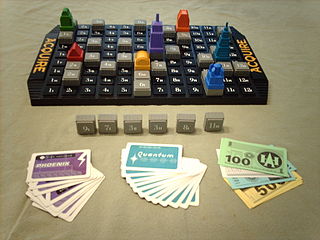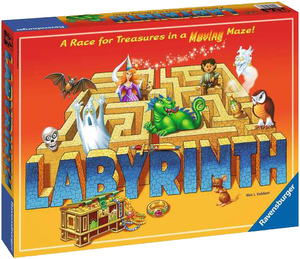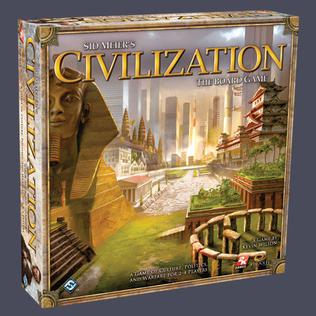Related Research Articles

Acquire is a board game published by 3M in 1964 that involves multi-player mergers and acquisitions. It was one of the most popular games in the 3M Bookshelf games series published in the 1960s, and the only one still published in the United States.

Monopoly is a multi-player economics-themed board game. In the game, players roll two dice to move around the game board, buying and trading properties and developing them with houses and hotels. Players collect rent from their opponents and aim to drive them into bankruptcy. Money can also be gained or lost through Chance and Community Chest cards and tax squares. Players receive a salary every time they pass "Go" and can end up in jail, from which they cannot move until they have met one of three conditions. House rules, hundreds of different editions, many spin-offs, and related media exist. Monopoly has become a part of international popular culture, having been licensed locally in more than 103 countries and printed in more than 37 languages. As of 2015, it was estimated that the game had sold 275 million copies worldwide. The original game was based on locations in Atlantic City, New Jersey, U.S.

Scotland Yard is a board game in which a team of players controlling different detectives cooperate to track down a player controlling a criminal as they move around a board representing the streets of London. It was first published in 1983. It is named after Scotland Yard which is the headquarters of London's Metropolitan Police Service in real-life. Scotland Yard is an asymmetric board game, during which the detective players cooperatively solve a variant of the pursuit–evasion problem. The game is published by Ravensburger in most of Europe and Canada and by Milton Bradley in the United States. It received the Spiel des Jahres award in 1983-the same year that it was published.

Civilization is a board game designed by Francis Tresham, published in the United Kingdom in 1980 by Hartland Trefoil, and in the United States in 1981 by Avalon Hill. The Civilization brand is now owned by Hasbro. It was out of print for many years, before Gibsons Games republished it in 2018. The game typically takes eight or more hours to play and is for two to seven players.

18XX is the generic term for a series of board games that, with a few exceptions, recreate the building of railroad corporations during the 19th century; individual games within the series use particular years in the 19th century as their title, or "18" plus a two or more letter geographical designator. The games 2038, set in the future, and Poseidon and Ur, 1830 BC, both set in ancient history, are also regarded as 18XX titles as their game mechanics and titling nomenclature are similar despite variance from the common railroad/stock-market theme.

Times of Lore is a 1988 action role-playing game that was developed and published by Origin Systems for several platforms, including PC, Commodore 64/128, ZX Spectrum, Amstrad CPC, Atari ST, Apple II, NES, and Amiga.

Ticket to Ride is a railway-themed German-style board game designed by Alan R. Moon. It was illustrated by Julien Delval and Cyrille Daujean and published in 2004 by Days of Wonder. The game is also known as Zug um Zug (German), Les Aventuriers du Rail (French), Aventureros al Tren (Spanish), Wsiąść do pociągu (Polish), and Menolippu (Finnish).

Ace of Aces is a two-player combat picture book game designed by Alfred Leonardi and first published in 1980 by Nova Game Designs.

Arkham Horror is a cooperative adventure board game designed by Richard Launius, originally published in 1987 by Chaosium. The game is based on Chaosium's roleplaying game Call of Cthulhu, which is set in the Cthulhu mythos of H.P. Lovecraft and other horror writers. The game's second edition was released by Fantasy Flight Games in 2005, with a third edition in 2018.

Labyrinth is a board game for two to four players, published by Ravensburger in 1986.

Empire Builder is a railroad board game originally published by Mayfair Games in 1982 that underwent several editions and eventually branched out into international and fantastical locations.
221B Baker Street: The Master Detective Game is a board game featuring Arthur Conan Doyle's fictional detective Sherlock Holmes and developed by Jay Moriarty in 1975 and sold by the John N. Hansen Co. in the US since 1977. The players have to solve cases using the clues provided by visiting locations on the board such as 221B Baker Street, Scotland Yard, Apothecary and Pawn Broker.
Sherlock Holmes: Consulting Detective is a game originally published by Sleuth Publications in 1981. Multiple expansions and reprints of the game have since been released.

Conquistador, originally subtitled "The Age of Exploration: 1495–1600", is a board game published by Simulations Publications, Inc. (SPI) in 1976 that simulates the exploration of the New World in the 16th century. Players take on the role of European countries sending expeditions to find gold and establish colonies. Although the design uses the trappings of board wargames such as a hex map, combat is not a major part of the game.
Orient Express is a crime fiction board game published by Jumbo and Just Games. The game is based on the 1934 novel Murder on the Orient Express by Agatha Christie. The game was designed by Jeff Smets and released in 1985. The game contains 10 different murder cases, each of which can be played only once. Five new plots were released in 1987.
Wizards is a fantasy board game designed by Thomas Mosbø and Coral Mosbø.

Sid Meier's Civilization: The Board Game is a 2010 board game created by Kevin Wilson based on the Sid Meier's Civilization series of video games and published by Fantasy Flight Games. While the previous board game based on Sid Meier's Civilization, published by Eagle Games in 2002, was based on Civilization III, the 2010 version takes its primary inspiration from Civilization IV. Its expansions, Fame and Fortune and Wisdom and Warfare, also began to incorporate concepts derived from Civilization V.

Wizard's Quest is a fantasy board wargame published by Avalon Hill in 1979.
Borderlands is a board game for 2–4 players published by Eon Products in 1982.

Armada is a board game published by Jeux Descartes in 1986. After Jeux Descartes published a second edition, Eurogames published a third edition in 2001 that changed the theme of the game from colonisation to treasure-seeking pirates.